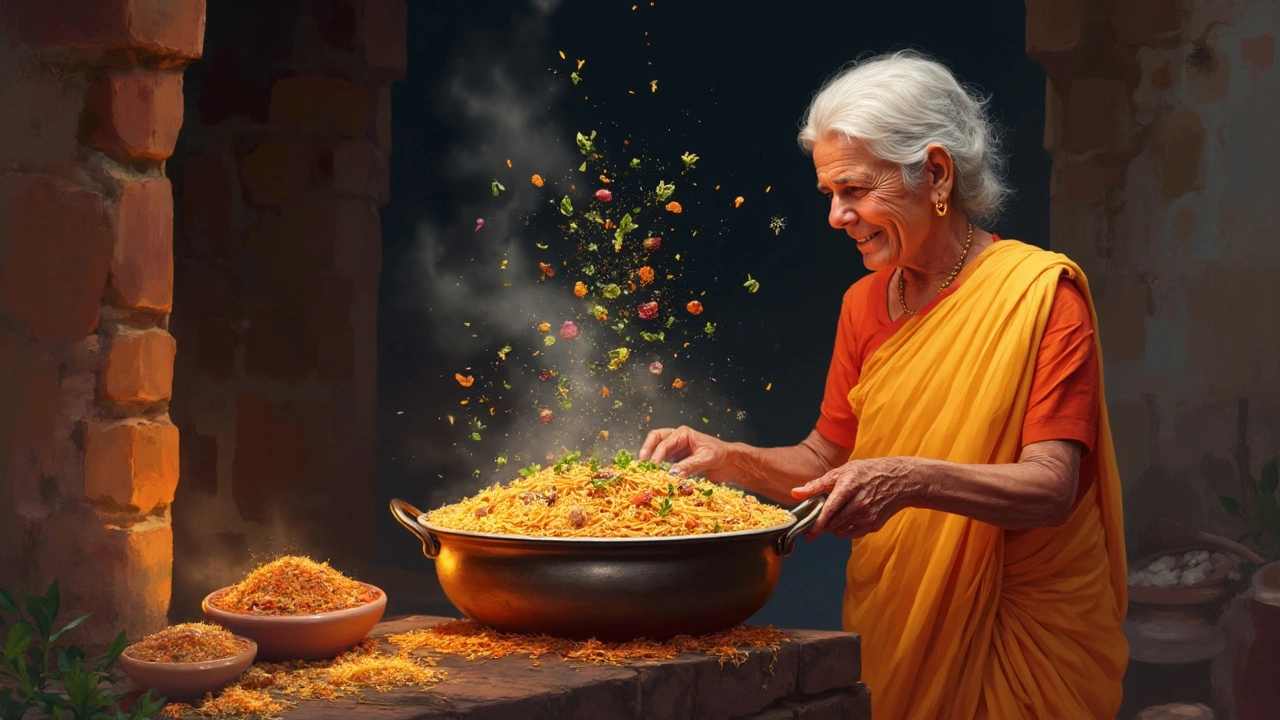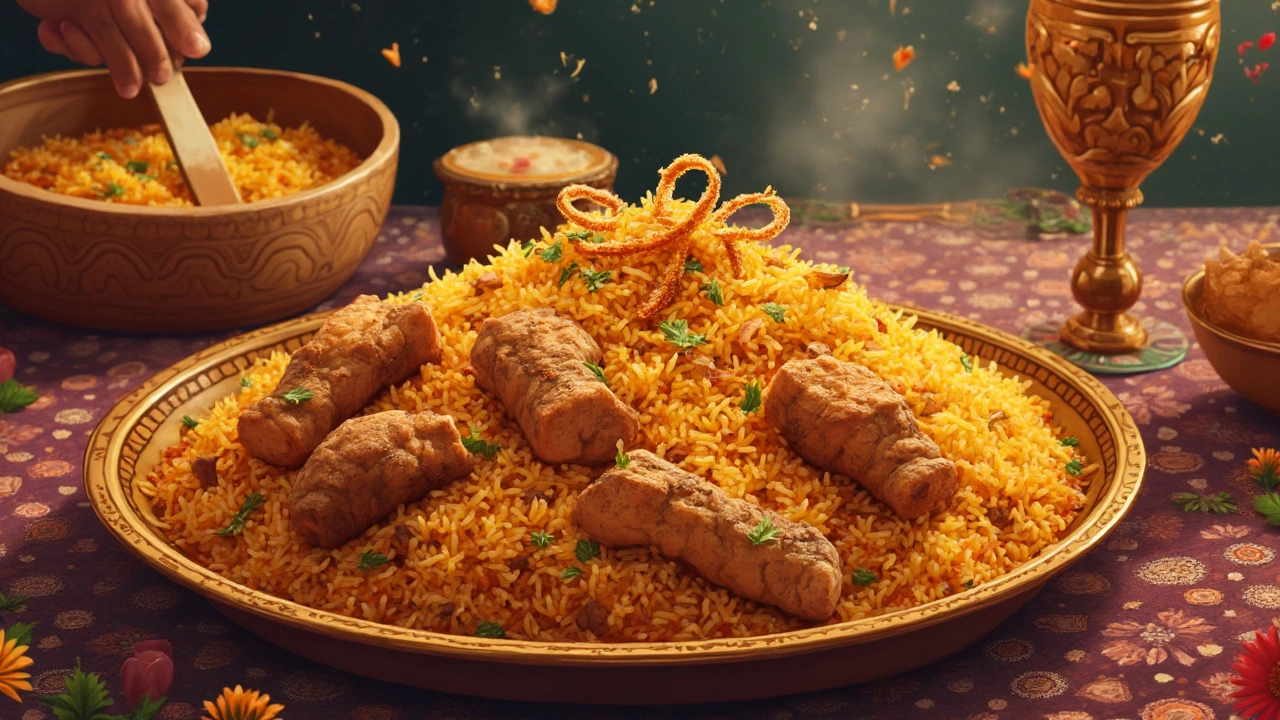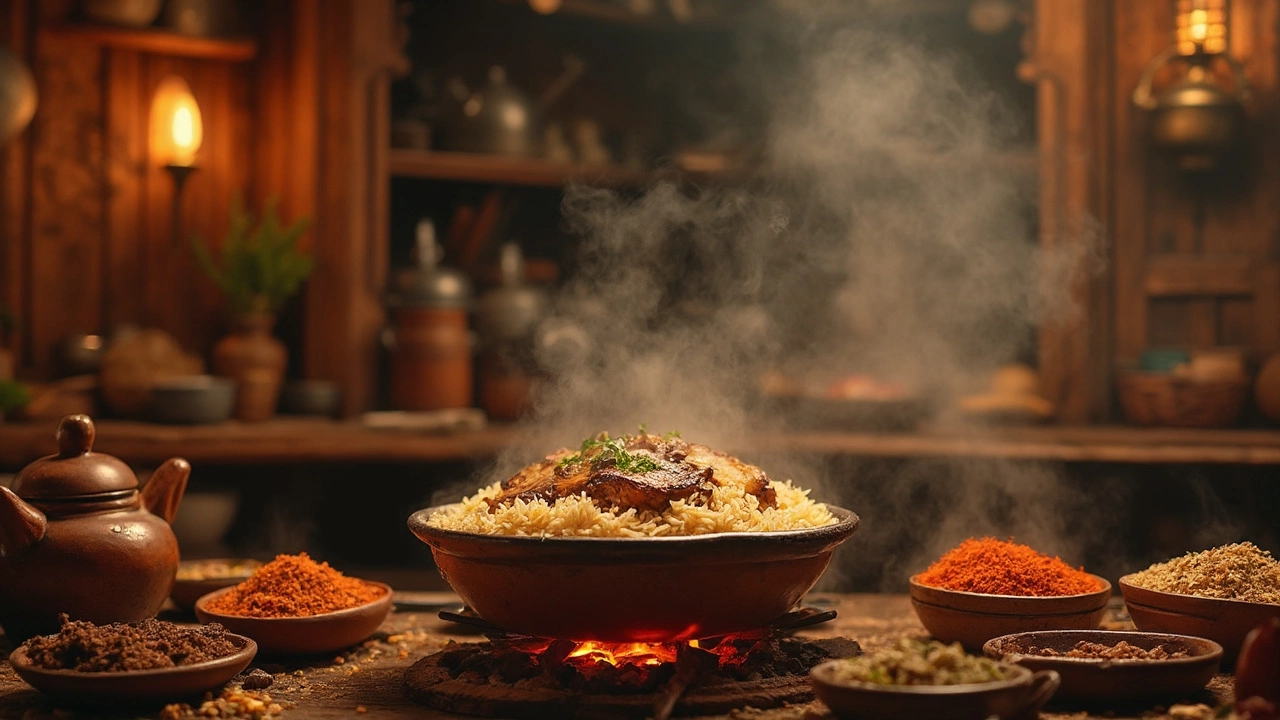6 Feb 2025
- 0 Comments
Biryani is like the symphony of the cooking world—everything needs to fall perfectly in place to create magic. Ever wondered why this heavenly dish takes what feels like an eternity to cook? Well, let's unravel this mystery.
First up, it's all about the layers. A good biryani isn't just thrown together in a pot. No, it's a multi-layered dish each with its own set of ingredients and precise timing. Every layer, whether it's the marinated meat or fragrant rice, must meld together in harmony. That's why patience is the key player here.
And then, there's the 'Dum'—the slow cooking technique that's pretty much a rite of passage for biryani. Cooking over low heat allows the flavors to seep into every grain of rice, every piece of meat. It's about creating depth and complexity, something you simply can't rush.
- Layers of Flavors
- The Art of 'Dum' Cooking
- Importance of Fresh Ingredients
- Managing Cooking Time
- Why the Wait is Worth It
Layers of Flavors
Let's talk about what makes biryani the star dish it is—the layers of flavors that each play their own part. It's not just about throwing everything into a pot and hoping for the best. Each layer in a biryani is crafted with love and intent, and that's what makes each bite an explosion of taste.
Marinating the Meat
The journey begins with marinating the meat. This isn't just a quick dip in some spices. We're talking hours, sometimes overnight, in a bath of yogurt, spices, and herbs. This not only adds flavor but also tenderizes the meat, making it juicy and scrumptious. The spices like cumin, coriander, and turmeric do the heavy lifting here, ensuring every bite is filled with richness.
Cooking the Rice
Now, the rice isn't just plain old boiled rice. Oh no, it's cooked with aromatic spices like cardamom, cloves, and a hint of saffron. This step ensures that when you finally dig in, every grain tells its own story. And, while we're at it, don't forget to cook the rice only to about 70% done. That way, it'll finish cooking perfectly during the 'Dum' phase.
The Fusion of Layers
Here's where the magic really happens—the layering process. Firstly, you spread a bed of partially cooked rice, add the marinated meat, and repeat. Some people add fried onions, boiled eggs, or even potatoes for an extra kick. Each layer needs to be handled with care because they all contribute to the final masterpiece.
Why Layers Matter
By structuring biryani this way, you ensure each section cooks evenly while absorbing real depth in flavor. It's a bit of an art and science combo, and that's why getting it right takes time. But let me assure you, one taste and you'll know the wait was worth it!
The Art of 'Dum' Cooking
So, what's all the fuss about 'Dum' cooking when it comes to biryani? Well, let's get into it. The term 'Dum' refers to a style of cooking where the food is slowly cooked in its own steam over a low flame. This method allows for the flavors to intensify and blend beautifully.
Traditionally, this slow cook process involves sealing the pot with dough to trap the steam, which keeps the aroma and moisture intact. The pot is placed either on a 'tava' or a flat pan to prevent direct contact with the flame, ensuring even heat distribution. That gentle, gradual heating is what makes every bite of biryani a burst of flavor.
Why Bother with 'Dum'?
It may seem like an extra step, but 'Dum' cooking is crucial if you want your biryani to taste like it was meant to. Here’s why:
- It allows the meat to tenderize perfectly, soaking in all those spices.
- The rice absorbs rich flavors without turning mushy.
- It keeps the dish moist yet fluffy, with each grain of rice distinct.
How to 'Dum' Like a Pro
Feeling inspired to try it yourself? Here’s a basic rundown:
- Layer partially cooked rice and marinated meat alternately in a heavy-bottomed pot.
- Seal the edges with dough or aluminum foil to keep the steam in.
- Place the pot on a low flame or over a pan on direct heat.
- Let it cook patiently for about 20-40 minutes, depending on the recipe.
It's all about patience and allowing the steam to work its magic. But trust me, once you've mastered 'Dum,' you won't look back. It's the secret sauce, if you will, to authentic biryani's irresistible allure.

Importance of Fresh Ingredients
When it comes to crafting the perfect biryani, fresh ingredients are the true unsung heroes. Imagine building a strong, flavorful base—it all starts with the quality of what's going in. Fresh vegetables, meats, and especially spices can make a world of difference.
Let's talk spices. They aren't just there for the taste; they infuse the dish with aroma and color. Using freshly ground spices, like cumin or coriander, packs in more punch than the ones lurking in the back of your pantry for ages. A tip? Buy whole spices and grind them yourself. It preserves their natural oils and intensifies the flavors.
And then there's the produce. Fresh veggies bring in a vibrant, crisp quality to your biryani. If you can, go for local and seasonal produce. They not only taste better but are also often more nutrient-rich.
Why Fresh Meat Matters
Ever heard the saying, "You are what you eat"? Well, in the biryani world, one could say, "Your dish tastes like the meat you choose." Using fresh, high-quality meat means tenderness and flavor in every bite. Fresh chicken, for instance, absorbs marinades better, ensuring a juicy, flavorful outcome.
Quick Tips to Keep in Mind
- Always look for bright, firm vegetables without blemishes.
- For meats, trust your sense of smell—fresh meat has a mild, clean smell.
- When buying spices, whole is better—grind them fresh for better flavor.
Consider this: Preparing your biryani with fresh, quality ingredients may add a bit of effort, but the results? Simply unbeatable. It's the secret to elevating your dish from good to unforgettable.
Managing Cooking Time
We've all been there—standing impatiently in front of the stove, wondering why the biryani isn’t done yet. So how can you manage the cooking time without cutting corners? Let’s dig into some practical tips.
Mindful Preparation
Preparation is key to cutting down cooking time without compromising on flavor. Start by soaking the rice for at least 30 minutes; this helps it cook faster. Similarly, marinating the meat overnight tenderizes it, ensuring it cooks more quickly and juicy. Have all your spices and ingredients ready to go before you start the actual cooking; you'll save a lot of time just by being organized.
Correct 'Dum' Technique
The 'Dum' method is all about cooking over low heat, but you can still manage time effectively. Use a heavy-bottomed pot to ensure even heat distribution, which helps cook the biryani layers uniformly. Seal the pot with dough to trap the steam, speeding up the cooking process by keeping the heat inside.
Efficient Layering
Sometimes, a tiny tweak makes a big difference. Layering rice and meat in smaller batches instead of one full layer allows them to cook evenly and quicker. And don't forget to sprinkle fried onions and herbs sparingly at each level for quicker absorption of flavors.
Time Management Tips
- Use a pressure cooker for the initial meat cooking stage if you're in a rush.
- Set timers for each phase: marination, pre-cooking the rice, and layering, to keep track of time efficiently.
- Consider using an oven for the 'Dum' part if you're cooking for larger crowds. It offers more even heat and frees up your stove.
All these tips ensure you're cutting down preparation and cooking time without cheating your taste buds. Remember, a little patience goes a long way, but smart cooking goes even further!

Why the Wait is Worth It
Alright, so we've established that cooking biryani takes time. But trust me, every minute of waiting is justified. The process transforms simple ingredients into a spectacular meal that’s hard to beat.
For starters, allowing enough time for the slow cook method helps in infusing all the spices and herbs thoroughly. This technique ensures that each bite is packed with a perfect balance of flavors. It's the kind of dish where patience actually tastes better—it’s that good!
Nisha Madhulika, a renowned Indian chef, says, "Cooking biryani slowly ensures the rice absorbs every bit of flavor, making each grain a delight on your palate."
The long cook time isn’t just about flavor, though. It significantly impacts the texture. The low and slow heat ensures the meat is tender and juicy, avoiding the rubbery texture you get when you rush things. The rice, fluffy and perfectly cooked, strikes a balance that’s key to this dish.
Stats Speak Too
Believe it or not, patience can be measured! A study done on traditional Indian recipes revealed that biryani ranked among the top five dishes people are willing to wait the longest time to cook.
| Dish | Average Cooking Time (minutes) |
|---|---|
| Biryani | 90 |
| Butter Chicken | 60 |
Imagine serving a dish that’s not just food but an experience in itself. Yes, the aroma filling your kitchen, anticipation building with every tick of the clock, makes every bit of effort worth it. So next time you find yourself waiting for that biryani to cook, remember, you're creating more than a meal—you're crafting a masterpiece!
